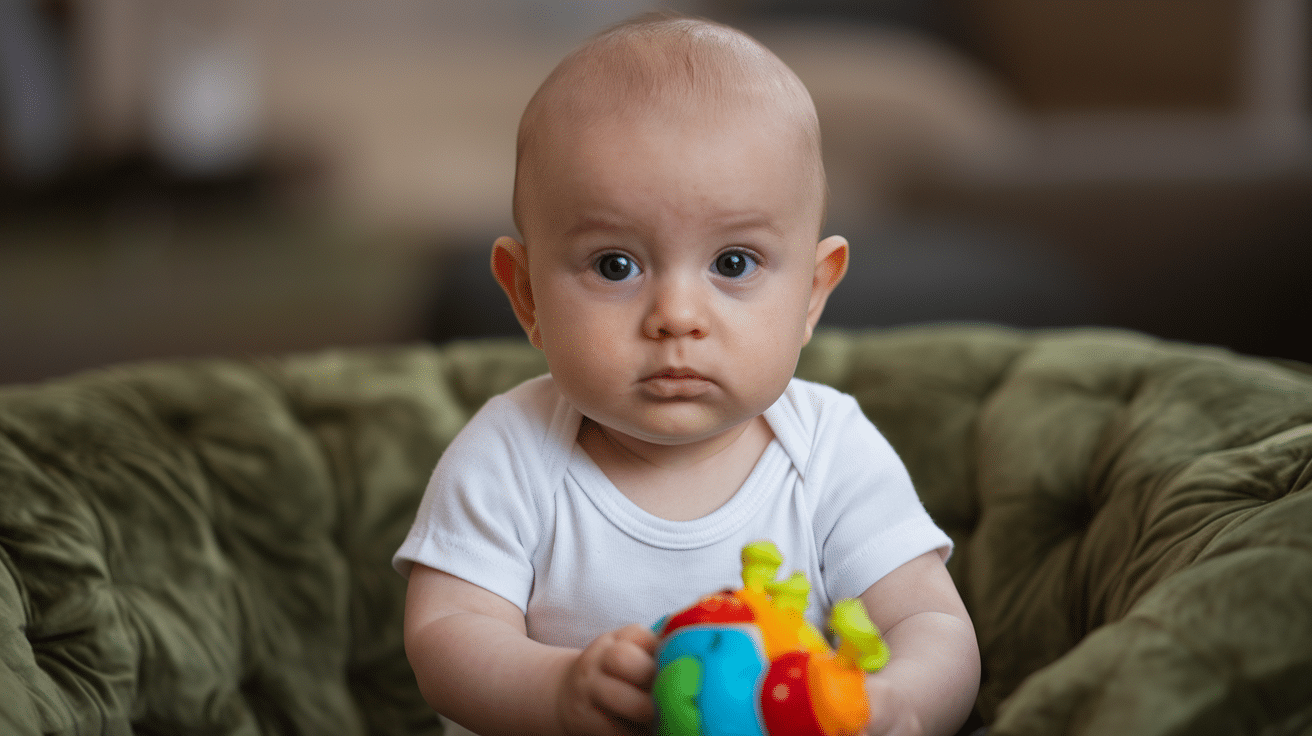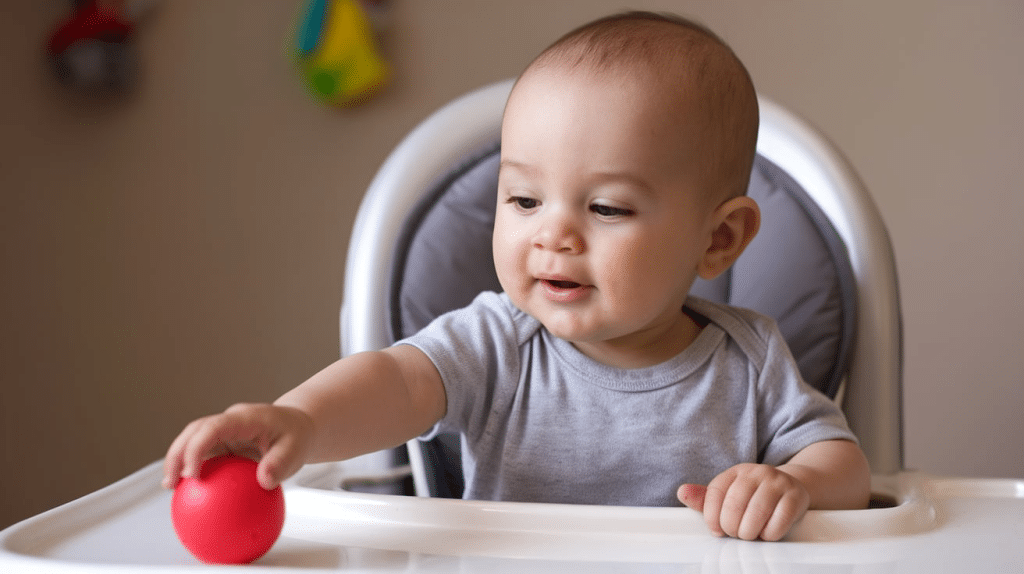Watching your baby grow is full of little surprises, and one of the big ones is the moment they start reaching for things. It might be a toy, your hand, or even their own feet.
I once wondered when babies start reaching for things, and learned that this skill develops step by step.
In this guide, you’ll see a month-by-month timeline of what to expect, ways you can encourage reaching, why it matters for development, and when to check with a doctor.
This way, you’ll feel reassured and ready as your baby builds this important milestone.
When Do Babies Start Reaching For Things: A Timeline
Babies learn to reach and grab in small steps, not all at once. Each month brings a new skill, and it all builds up to better control and coordination. Below is a simple timeline to help you understand what to expect.
0–2 Months: Reflexive Grasp
In the first couple of months, babies don’t reach on purpose. Instead, they have a strong reflex called the “palmar grasp.” If you place your finger in their tiny hand, they’ll curl their fingers around it.
This reflex is automatic, not a choice. Still, it’s an early sign of how their muscles and brain will eventually work together. You may notice them holding on tight but then letting go suddenly.
3 Months: Batting at Toys
By around 3 months, babies begin moving their arms more freely. They may wave or “bat” at dangling toys or objects in front of them. These motions are often unsteady but show they’re learning how to use their hands.
This stage is important because they’re starting to connect what they see with how their arms move. Their vision is sharper now, so they notice toys, lights, or your face and try to make contact.
4 Months: Intentional Reaching Begins
At 4 months, reaching becomes more deliberate. Babies may stretch toward toys, your face, or even a bottle they see in front of them. This shows they’re learning coordination between their eyes and hands.
They might not always succeed, but the effort matters. These early attempts are practice, helping them build muscle strength and control for more accurate grabs in the coming months.
5 Months: Two-Handed Grabs and Rolling
Around 5 months, babies get stronger and more coordinated. They often use both hands together to grab toys. You might see them rolling to reach something just out of their way.
They can hold items for longer now, though they’ll still drop them often. This stage also introduces “midline play,” where babies bring their hands together at the center of their body to examine or grab objects.
6 Months: Full-Hand Grasp and Transfers
At 6 months, grasping becomes more solid. Babies use their whole hand, called a “palmar grasp,” to hold onto toys or objects. They’re better at picking things up and keeping hold of them.
Another milestone is transferring objects from one hand to the other. This might look small, but it shows big progress in motor skills and brain development. They’re learning to use both sides of the body together.
7–9 Months: Improved Control
Between 7 and 9 months, babies show much more control. They may grab their feet, play with toys more carefully, or put objects in their mouth.
At this stage, their movements look smoother and more purposeful. They can reach across their body, grab smaller objects, and switch toys easily. You’ll see more curiosity and focus as they find their world through touch.
How to Encourage Your Baby to Reach

You can help your baby practice reaching with small, safe activities. These moments make playtime fun while also building strength and coordination.
- Use safe dangling toys – Hang a lightweight rattle or soft toy just above your baby so they can practice stretching and swatting at it.
- Talk and sing – Your voice draws their attention and keeps them engaged. It also helps them connect sounds with movement.
- Tummy time for strength – Lying on their tummy builds neck, shoulder, and arm muscles, making it easier for them to push up and reach.
- Offer simple, soft toys – Place easy-to-grasp toys in front of them. This gives your baby chances to practice holding and passing objects.
Why Reaching Matters for Your Baby’s Development
Reaching isn’t just a fun milestone – it’s an important step in your baby’s growth. Each attempt to grab a toy builds new skills for the months ahead.
| Benefit | Why It’s Important | How It Helps Babies |
|---|---|---|
| Hand-eye coordination | Connects what babies see with how their hands move | Improves control for grasping, playing, and learning |
| Brain & motor development | Builds brain pathways and strengthens muscles | Prepares for rolling, sitting, crawling, and walking |
| Foundation for milestones | Supports skills needed as they grow | Helps with crawling, self-feeding, and playful learning |
| Social interaction | Encourages bonding and early communication | Reaching for toys or people strengthens social skills |
| Confidence & curiosity | Every successful grab builds self-trust | Motivates babies to learn more |
When to Talk to a Doctor
Most babies develop on their own timeline, but a few signs mean it’s worth checking with your pediatrician.
- Not reaching by 6 months – This could suggest a delay in motor or vision development, and early support can be helpful.
- Stiff or floppy arms – If your baby’s arms seem unusually tight or weak, it may signal an underlying muscle concern.
- No interest in toys – A baby who shows little curiosity about objects may be facing developmental or sensory challenges.
- Vision concerns – Trouble focusing, tracking objects, or making eye contact can affect how your baby learns to reach.
Reassurance for Parents
It’s natural to feel anxious if your baby isn’t reaching milestones right when you expect.
But skills like reaching develop at different paces, and every child’s timeline is unique. Some may start at 3 months, while others take closer to 6 months.
A slight delay doesn’t always signal a problem. Many babies catch up naturally once their muscles grow stronger or their vision sharpens. What may seem like a setback is often just part of their normal growth pattern.
You can support your baby with simple activities like tummy time, dangling toys, or letting them hold your fingers. And when in doubt, always check with your pediatrician.
Conclusion
Now you know the answer to when babies start reaching for things and why it matters for your little one’s growth.
Most babies begin reaching with purpose around 4 months and get more coordinated by 6 months, but every child moves at their own pace.
I remember worrying when my baby took a little longer, but simple play and patience made all the difference. Keep engaging, watch for progress, and check in with your pediatrician if you’re unsure.
Have you noticed your baby trying to reach yet? Share your experience in the comments!











